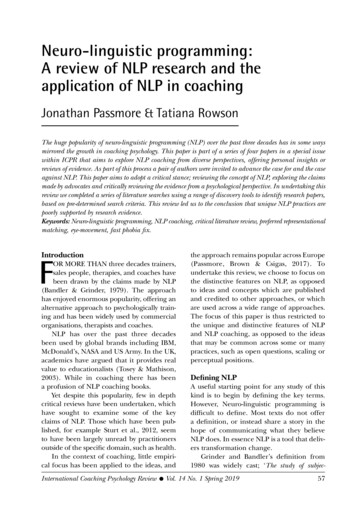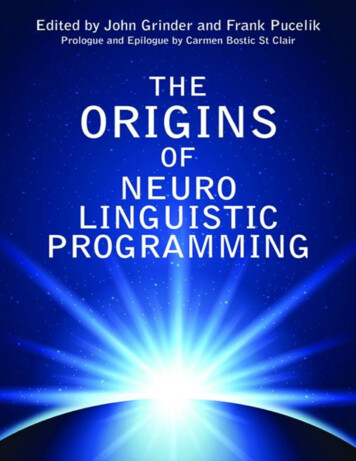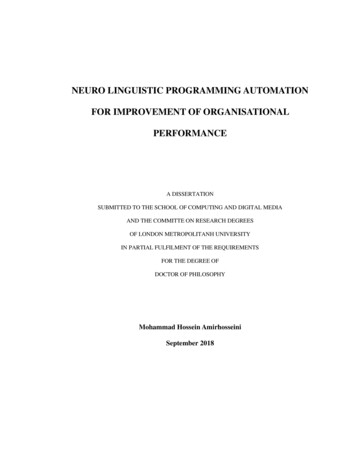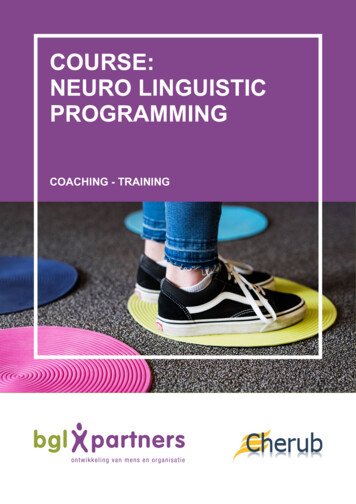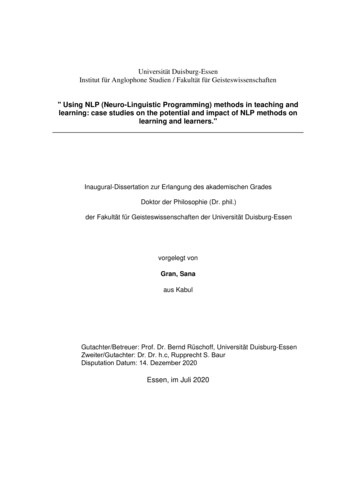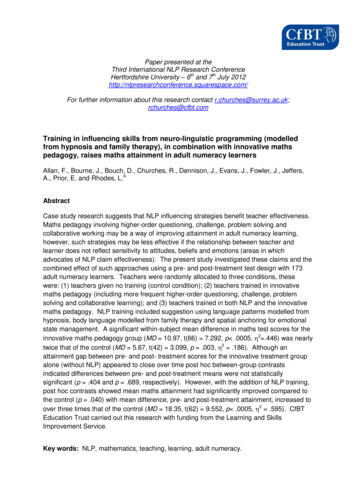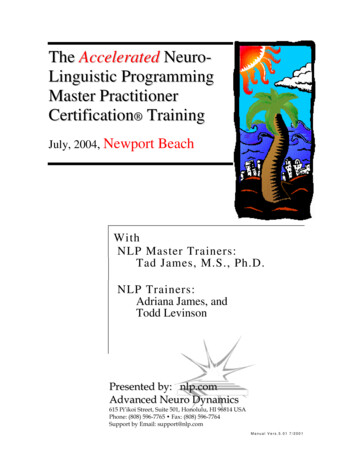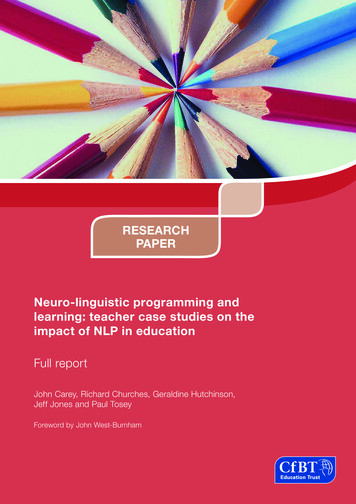
Transcription
RESEARCHPAPERNeuro-linguistic programming andlearning: teacher case studies on theimpact of NLP in educationFull reportJohn Carey, Richard Churches, Geraldine Hutchinson,Jeff Jones and Paul ToseyForeword by John West-Burnham1
Neuro-linguistic programming and learning: teachercase studies on the impact of NLP in educationWelcome to CfBT Education TrustCfBT Education Trust is a top 50 UK charityproviding education services for public benefitin the UK and internationally. Established 40years ago, CfBT Education Trust now has anannual turnover exceeding 100 million andemploys 2,300 staff worldwide who supporteducational reform, teach, advise, researchand train.Since we were founded, we have worked inmore than 40 countries around the world. Ourwork involves teacher and leadership training,curriculum design and school improvementservices. The majority of staff provide servicesdirect to learners: in nurseries, schools andacademies; through projects for excludedpupils; in young offender institutions and inadvice and guidance centres for young people.Schools and Families (DCSF), the Office forStandards in Education (Ofsted), and localauthorities. Internationally, we work witheducational ministries in Dubai, Abu Dhabi andSingapore among many others.Surpluses generated by our operationsare reinvested in educational research anddevelopment. Our research programme –Evidence for Education – aims to improveeducational practice on the ground and widenaccess to research in the UK and overseas.Visit www.cfbt.com for more information.We have worked successfully to implementreform programmes for governmentsthroughout the world. Government clients inthe UK include the Department for Children,AcknowledgementsThis research publication could not havebeen produced without the 24 teachers whoput so much effort and personal time intothe case studies: Nina Blanchet, TraceyBurns, Louise Causer, Robin Charlton,Rachael Coull, Joanna Dobson, HelenFuhr, Gillian Hogg, Laura Holland, NicolaHurst, Stephanie Kidd, Louise Lightley,Emma Loader, Jaqueline Lorimer, NigelMaddison, Julie Newton, Fiona MacGregor,Ian McDuff, Diane Murphy, Mark Phillips,Simon Potter, Zoe Ryan, Erica Tait, EmmaVolpe, Michell Whall and Janice Woods.We would like to thank them particularly fortheir contributions to this paper and for thesupport of their schools in carrying out theresearch projects. Acknowledgement shouldThe views and opinions expressed in this publication are those of the authorand do not necessarily represent the views of CfBT Education Trust. CfBT copyright 2010 All rights reservedThis report is available at www.cfbt.comwww.cfbt.com2also be made to the Training and DevelopmentAgency for Schools (TDA) for providing initialfunding to train some of the teachers in NLPas part of the grant-funded Leading Thinkingproject. Finally thanks go to the University ofSurrey NLP Research Project for providingaccess to its NLP research database andparticularly to Jane Mathison for access to herresearch and work.
Neuro-linguistic programming and learning: teachercase studies on the impact of NLP in t the authors4Abstract4Foreword5Executive summary61. Purpose and background to this research paper72. The evidence about the use of NLP in education – a review of the literature93. Background to the teacher-led action research case studies134. Methodology165. Teacher evidence in the 24 case studies – a summary196. Wider benefits and impact of the project267. Summary and general conclusions about NLP and current thinking in education308. Recommendations for further research339. Glossary for the areas of NLP that were the focus of the various case studies35Appendix 1 – The evidence about the use of NLP in education – a review of the literature(continuation and detailed evidence and discussions)37Appendix 2 – The 24 teacher case study write-ups57References973
Neuro-linguistic programming and learning: teachercase studies on the impact of NLP in educationAbout the authorsJohn Carey was Senior Education Inspector inDurham Local Education Authority and is nowDirector of Still Point Solutions Ltd. He leadsthe North East’s consortium of schools, localauthorities and the universities of Durham,Newcastle, Northumbria and Sunderlanddelivering the new Masters in Teaching andLearning (MTL).Richard Churches is Principal Consultantfor National Programmes at CfBT EducationTrust. Over the last seven years, he has beenthe professional lead for a number of majorgovernment education reform programmes.He is also a member of the University of SurreyNLP Research Programme.Geraldine Hutchinson is Assistant Directorfor National Programmes at CfBT EducationTrust. For over a decade she has lednumerous significant national governmentinitiatives as well as writing research. Beforejoining CfBT Education Trust she was at SouthBank University.Jeff Jones is Principal Consultant at CfBTEducation Trust. He has researched andpublished extensively in the areas of continuingprofessional development, school leadershipand management, performance management,and school governance.Paul Tosey is the Senior Lecturer in the Schoolof Management at Surrey University. He is aleading authority on the academic appraisalof NLP and co-author with Jane Mathisonof Neuro-Linguistic Programming: A CriticalAppreciation for Managers and Developers.This paper was first presented at an EducationShow seminar, sponsored by CfBT EducationTrust on 6 March 2010. Conference paperversions of the literature review and casestudy research will be presented at the 2ndInternational NLP Research Conference at theUniversity of Cardiff in July 2010.AbstractThis research paper reports on evidence from24 teacher-led action research case studiesand builds on the 2008 CfBT Education Trustpublished paper by Richard Churches andJohn West-Burnham ‘Leading learning throughrelationships: the implications of Neurolinguistic programming for personalisation andthe children’s agenda in England’.The current research focused on two gaps inthe research literature: T he absence of any formal and systematicliterature review of evidence in relation to theimpact and use of NLP in education T he lack of any substantive teacher-led andclassroom-based action research in this area.Teachers followed the Teacher LearningAcademy framework in designing andimplementing their research – a frameworkthat CfBT Education Trust was closely involvedin the development of. All of the case studieswww.cfbt.com4demonstrate significant impact in relation toteacher development, with many demonstratingpositive impacts on pupil learning outcomes.The paper also contains the first systematicand comprehensive literature review of researchevidence into the impact of NLP in educationand discusses the content of 111 papers andreferences including quantitative and qualitativeresearch evidence. The majority of publishedwork was found to be supportive of the useof NLP in schools and education although,as the authors point out, this should only beconsidered as an interim finding because of thewide range of methods used and variations inthe quality of some of the research.To reference this research:Carey, J., Churches, R., Hutchinson, G., Jones, J.and Tosey, P. (2009) (foreword by John WestBurnham) Neuro-linguistic programming andlearning: teacher case studies on the impact ofNLP in education, Reading: CfBT Education Trust.
Neuro-linguistic programming and learning: teachercase studies on the impact of NLP in educationForeword‘‘After thousands of years of formalised humaneducation we still seem to be no nearer to adegree of consensus as to what might constitutean effective educational process. If we set asidethe contextual variables that play such a pivotalrole in educational success – factors such asthe family, social class and poverty – then wecan begin to explore the key school basedvariables – the curriculum, teaching and learning. a balance ofauthoritative thinkingabout the natureof the learningprocess combinedwith compelling andconvincing casestudies. . . among school level variables, the factorsthat are closest to student learning, suchas teacher quality and classroom practices,tend to have the strongest impact onstudent achievement.(Pont et al, 2008: 33)It’s probably fair to say that we have exploredmost permutations of what a curriculum mightcomprise. In spite of the stubborn focus onsubjects and the burden of information we canbe reasonably confident that we understandthe possibilities of a curriculum.It might be argued that the interaction betweenteaching and learning is that of the relationshipbetween art and science. We probably knowmore about effective teaching than ever beforeand the artistry of the skilled teacher, mentoror facilitator is a vital element of effectivelearning. Equally we are growing in confidenceabout the scientific basis of learning:‘‘Education is neither writing on a blank slatenor allowing the child’s nobility to come intoflower. Rather education is a technology thattries to make up for what the human mind isinnately bad at.(Pinker, 2002: 222)Our genetic and evolutionary inheritance meansthat we have a predisposition to speak; we donot have such a predisposition to write or toread. Education is a process of compensatingfor gaps in our biological inheritance andadapting natural predispositions ‘to masterproblems for which they were not designed’.(Pinker, 2002: 223)And this offers priorities for educationalpolicy: to provide students with the cognitivewww.cfbt.com5tools that are most important for graspingthe modern world and that are most unlikethe cognitive tools they are born with.(Pinker, 2002: 235)This is an argument for both a betterunderstanding of the impact of our geneticinheritance and recognition that the blank slateand genetic determinism arguments are bothwrong. Ridley (2003) argues:Nature versus nurture is dead. Long livenature via nurture.(Ridley, 2003: 280)Our capacity to learn is the result of complexinteractions and if we are to respond to theimperative of securing excellence and equityacross the education system we need toenhance our understanding of how to maximiseeffective learning and teaching. That is exactlywhat this timely and significant report does. Forthe first time it offers a balance of authoritativethinking about the nature of the learningprocess combined with compelling andconvincing case studies of successful practice.This report provides a comprehensive anddetailed survey of how NLP relates to effectivelearning and teaching and so increases ourconfidence in continuing to explore and extendour understanding of its potential.John West-BurnhamProfessor of Educational Leadership,St Mary’s University College
Neuro-linguistic programming and learning: teachercase studies on the impact of NLP in educationExecutive summary‘‘This researchhas provided aunique opportunityfor teachers topresent their firsthand practiceevidence The aim of this report is to address twosignificant gaps in the research literature: theabsence of any formal and systematic literaturereview of evidence in relation to the impact anduse of NLP in education, and the lack of anysubstantive teacher-led and classroom-basedaction research in this area. NLP is a relativelynew field of study, especially in relation to itsapplication within education, and this may wellhave contributed to this gap in the literature;however, given the general consensus on theimportance of interaction and communicationin teaching and learning (alongside subjectknowledge), the extent of the gap is perhapshard to explain. The 24 teacher-led actionresearch case studies presented in this reportdemonstrate that ‘teachers’ recognise theimportance of communication in effectivelearning and teaching, and more so,understand the potential of the application ofNLP to achieve this, particularly in relation tolanguage and learning, rapport, interpersonalskills and flexibility.‘‘NLP is aligned in the literature to wide-rangingfields of practice, which perhaps normally areconsidered separate and which have distinctlydifferent stakeholders. However, presence inthe academic arena is still sparse – a fact that isnoted in the first comprehensive appraisal of NLPthat was published this year – Neuro-LinguisticProgramming: a critical appreciation formanager and developer (Tosey and Mathison,2009) and in Neurolinguistic psychotherapy: apostmodern perspective (Wake, 2008); both ofwhich have sought to reposition NLP as a fieldripe for serious academic study.The systematic review of literature in thispublication includes the documentation andanalysis of 111 references, including many thatcontain quantitative and qualitative evidence.Whilst the territory of NLP is sometimesportrayed contentiously (though often in writingthat is not based on substantive evidence) themajority of research papers and perspectivescontain discussions about the use of NLP inclassroom practice that are positive towardsit. It was also clear from the literature thatcontrary to some popular opinion, there havebeen a number of academic publications onwww.cfbt.com6NLP that are supportive of its use in schoolsand education in general.The teachers involved in the case studyteacher-led action research published hereused the General Teaching Council of England(GTCE)’s Teacher Learning Academy (TLA)framework as a structure for recording theirlearning. This meant that if they wished,they could submit their work to the TLA forprofessional recognition: so far three teachershave achieved accreditation at Level 1 and anumber of others are moving in this direction.The case studies analysed here offer insightsinto key NLP strategies, tools and practice thatcan be used in the classroom to create impacton relationships, behaviour, learning and pupilachievement and teaching effectiveness.Increasing young people’s access to learningopportunities, improving their achievementand adding value to teacher effectiveness areinextricably bound to the public investmentmade in teacher training, both initial andcontinuing. The goal surely is to increasebenefits for ever-increasing numbers oflearners in cost-effective and efficient ways,starting with teacher classroom practice.This research has provided a unique opportunityfor teachers to present their first-hand practiceevidence and for this to be placed in aresearch context so that there is a firm basisfor future discussions and an evidence-ledevaluation of NLP applied within teaching. Akey driver of this paper was the objective tofacilitate teachers’ reflective practice, and toshare the learning derived from that reflectionwithin and beyond the education community.The connection between development,practice, research and policy that this paperseeks to influence through taking as itsstarting point teacher evidence of the impactof new practices, materials and capabilities,uncovers the questions that research needs toaddress. New knowledge and skills developmentfor teachers is a key outcome of these casestudies and in an education system where socialand economic prosperity are goals the way inwhich knowledge about educational practice ispresented and applied is of major importance.
Neuro-linguistic programming and learning: teachercase studies on the impact of NLP in education1. Purpose and background to thisresearch paper‘‘This resultedin the inclusionof a number ofnew ideas frompsychology andother relateddisciplines.In 2008 CfBT Education Trust published aresearch paper by Richard Churches andJohn West-Burnham: Leading learningthrough relationships: the implicationsof Neuro-linguistic programming forpersonalisation and the children’s agendain England (Churches and West-Burnham,2008). This paper discussed research andthinking on the importance of interpersonaland intrapersonal effectiveness for teachers,school leaders and school improvement, andexplored implications of the use of NeuroLinguistic Programming (NLP) in relation topersonalisation and the children’s agenda.It outlined initial research carried out as partof the Fast Track Teaching programme –the UK government accelerated leadershipdevelopment programme (a contract that CfBTEducation Trust held with the Departmentfor Education and Skills (DfES) and then theNational College for School Leadership (NCSL)for eight years). The paper also included abrief summary of the use of NLP as part ofthe London Leadership Strategy and madesuggestions for further research. Evidencefrom this paper was presented at the FirstInternational NLP Research Conference at theUniversity of Surrey in July 2008 (Churchesand West-Burnham, 2009).‘‘The inclusion of NLP in the Fast Track Teachingprogramme evolved from a recognition of theimportance of communication skills in effectiveteaching as a support to subject knowledgeand sound pedagogy; and in relation toeffective influencing in school leadership. Itwas clear from the outset that there was, atthe time of the inception the programme, littletraining and development that could be saidto have got to the heart of the challenge ofeffective communication. CfBT EducationTrust consultants audited and attended awide range of training from within education,as well as from the private sector, in order toidentify training that might fill this development http://www.eep.ac.uk/, accessed 17 November 2009.1www.cfbt.com7gap. This resulted in the inclusion of anumber of new ideas from psychology andother related disciplines. All such inclusions,including NLP, were piloted on a trial basiswith a view to identifying those that theteachers themselves pointed to as beingeffective and then researching their impact.In this sense, development by necessitycame before research; and the use ofNLP on Fast Track parallels some of theprocesses identified by Andrew Morris,Charles Desforges and others (Morris, 2004;Desforges, Morris and Stanton, 2005; Morris,2009) as being important for the furtherevolution of teaching as an evidence-basedprofession. In particular, in 2004 the NationalEducation Research Forum recommendedtwo strategic priorities: t he creation of a national evidence system,accessible to all t he encouragement of programmes thatcombine development and research (NERF,2004) (Desforges, Morris and Stanton,2005: 3)CfBT Education Trust has embraced bothof these concepts, firstly in its support forthe development of an online EducationalEvidence Portal (eep)1 and secondly with someof our key national delivery programmes suchas Fast Track Teaching and our subsequentongoing interest in Development and Researchin areas such as NLP in education, coachingand the application of ideas from appliedpsychology to educational leadership.Research papers are currently in preparationacross all of these areas.The first research paper by Churches andWest-Burnham (2008) was primarily aperspectives paper and the need to publishresearch on both the impact of NLP on childrenand teacher professional development wasclearly highlighted by this publication. The
Neuro-linguistic programming and learning: teachercase studies on the impact of NLP in educationpaper noted the strongly positive way in whichNLP had been received by a large number ofteachers and identified areas for the applicationof NLP. It was also clear that no systematicliterature review had yet taken place in relationto NLP and education.The purpose of this research publication istwo-fold: firstly, to document the extent andscope of publications on NLP (both researchwww.cfbt.com8publications and the growing popular literature);and secondly, to fill a key gap in the evidencewhich emerged from that literature review(namely the lack of teacher-led action researchcase studies). As well as these aims, thissecond publication has sought to extend theresearch evidence beyond participants on theFast Track Teaching programme and recordsevidence of impact from teachers without adirect connection to the programme.
Neuro-linguistic programming and learning: teachercase studies on the impact of NLP in education2. The evidence about the use of NLP ineducation – a review of the literature‘‘The purposeof this review isto scrutinise thepublished evidenceand academicopinion on theeffectiveness ofNLP to supportteaching andlearning The review focused on the publication inthe English language of academic research,perspectives and articles on the use of Neurolinguistic programming (NLP) in education.However, we are also aware of a developingliterature in other languages, particularly inEurope (see e.g. Hager, 1989; 1990; 1992;Otto; 2006; Özmen, 2009; Schaefer andSchajor, 1999; Zechmeister, 2003).There have been occasional critical academiccommentaries (Marcus and Choi, 1994; Craft,2001), brief critical comments (Lisle, 2005;Burton, 2007) and at least one negativediscussion in the popular press (e.g. Beadle,2008) on the use of NLP in education.However, none of these has been based on areview of the specific NLP research evidenceand literature (as is noted by Tosey andMathison, 2009). The purpose of this reviewis to scrutinise the published evidence andacademic opinion on the effectiveness ofNLP to support teaching and learning, andthereby to put the 24 teacher-led actionresearch case studies contained in this paperinto a research context. As such, we believethat this is the first extensive review of theliterature on NLP in education to be published.‘‘Methodology and scope ofthe reviewAn initial literature search focused on theAustralian Education Index (AUEI) – 1979to date, British Education Index (BREI) –1975 to date and the Education ResourcesInformation Centre (ERIC) – 1966 to date.This produced 89 unique references andeight duplicate references.2 Review of thesereferences revealed 30 references that wereboth education-related (schools, further andhigher education, adult learning and/or theuse of NLP with children) and published inacademic or partially academic publications(what is sometimes known as ‘grey literature’),including conference papers and unpublishedtheses. Alongside this, two online databasesthat list, respectively, 193 and 311 referencesto NLP in journal articles, papers anddissertations were analysed and assessedincluding the database which is hosted by theUniversity of Bielefeld in Germany.3A further cross-check was made with alist of research references hosted by theNLP Research and Recognition Project.4These databases contained an additional33 unique references that fulfilled the searchcriteria. These data sets are discussed belowalongside 39 other references and papers thatwere recorded within the NLP and ResearchProject, based at Surrey University.5 Thisincludes three education papers presented aspart of the First International NLP ResearchConference (in Tosey, P., 2009). A total of 111out of 171 references have been includedin the formal analysis. In the vast majority ofcases we have been able to review the fullpublication; however, on occasions we haveincluded evidence from author abstracts alonebut only where these have provided sufficientevidence for analysis.In relation to the scope of the review we includeda wide range of sources: J ournal articles (although in many cases itwas difficult to ascertain the depth or scopeof peer review processes) Conference papers 1 July 2009. Search criteria: all references to Neurolinguistic programming OR Neuro-linguistic programmingOR Neuro linguistic programming. Data from the three sources was combined and all repetitions removed.3 e.htm; http://www.nlp.de/cgi-bin/research/nlp-rdb.cgi, 14 July 2009.4 http://nlprandr.org/. Note this list of references is only available on registration with the site, accessed2 December 2009.5 http://www.nlpresearch.org, accessed 14 July 2009.2www.cfbt.com9
Neuro-linguistic programming and learning: teachercase studies on the impact of NLP in education A rticles which had some form of universityaffiliation and articles whose writers hadsome form of university affiliation or trackrecord in research P apers connected to governmentprogrammes and which presentedevaluation data P ostgraduate level research findings (bothat Masters and Doctoral level) P ractitioner findings published in journalarticles and papers with some elementof university or recognised researchorganisation affiliation.These mean that informal research findingsand perspectives have been presentedalongside more formal methodologies andwritings. Our intention, however, was to becomprehensive rather than to provide adetailed critical reading. No doubt, as fieldsof study develop in the various domains andsub-domains of the topic, some referenceswill slip into obscurity as more robust evidenceis documented and emerges. Indeed thereis a wide range of quality in relation to themethodologies used in the studies and in theextent to which the findings can be viewedas secure. Where we have serious concernsabout the methods used, or the presentationof findings, we have indicated these in ourdiscussions. A widely scoped review like thiswill, we hope, improve and give more depthto any pre-research review of evidence priorto education research in areas where studieshave already taken place.In terms of the scope of the content we havetaken an equally broad view on the definition of‘education’. Thus we have included content thatrelates to research evidence or perspectivessuch as informal adult learning as well as moreobvious education domains such as classroompractice. In doing so we are aware that thescope of the review might be considered toobroad by some readers; however, growinginterest in the effectiveness of the adult learningof teachers themselves and its effect on pupiloutcomes may mean that some researchersfind these sources of interest alongside thepublications that relate specifically to childrenand young people. We did not, however,include areas such as: training in general,counselling, psychotherapy and family therapy.www.cfbt.com10Opinion pieces from teacher professionalmagazines were not included even wherethese were from recognised researchers orrespected authorities.Throughout this summary and in theextended review (see the appendices),references included in the formal analysisare (from this point on) indicated with anasterisk (e.g. Hillin, 1982*).Summary of findingsIt is sometimes implied that there is littleor no evidence base for areas of teacherprofessional practice such as NLP (see e.g.Burton, 2007*) or in relation to NLP in general(Heap, 1988; 2008; Roderique-Davies,2009). However, as this systematic reviewdemonstrates, there has been a growing anddeveloping education literature which refers toboth adults and children right from the time ofthe publication of the earliest popular bookson NLP and teaching and learning (Harper,1982; Dilts, 1983a; Jacobson, 1983 – seefor examples of early research: Hillin, 1982*;Fruchter, 1983*; Knowles, 1983*). Furthermore,criticisms (where they exist) are often made ata theoretical or ‘in principle’ level rather thanfrom an evidence-based position.The review highlighted two other issues: W hat NLP research literature there is, israrely cross-referenced to, or cited within,the NLP informed research, even thoughsome topics have been researched beforeand the results are accessible. F ew researchers or commentators havecarried out any form of literature review priorto the conducting of research.This is perhaps the result of the generalassumption that there is no evidence orresearch available or because a significantamount of the available evidence has onlyemerged in the last few years (22 out of the 92accessible papers and publications reviewedbelow are from 2007 onwards). In addition,although much of the recent evidence hasa university department origin, only a smallamount has as yet been published in easilyaccessible journals.
Neuro-linguistic programming and learning: teachercase studies on the impact of NLP in educationChurches and West-Burnham (2008; 2009)*suggest that NLP tools and techniquesrelevant to teachers and school leaders can beclassified in four ways: O utcomesStrategies and approaches for self-motivationand the motivation of others R apportApproaches for building rapport andinfluencing others F lexibilityTechniques for developing personal flexibilityand awareness of others L anguageLanguage models from hypnosis andtherapy (Churches and West-Burnham,2008: 7)Although the number of NLP-relatedpapers (including research publications anddissertations) is relatively small, there was someevidence in relation to each of these areas,particularly in relation to language and learning,rapport and interpersonal skills and flexibility.There was a mixture of both qualitative andquantitative evidence, with a smaller numberof papers that provide perspectives withoutassociated evidence. Most of the papers thatcontain specific evidence (52 out of a totalof 57) contained findings which their authorsclaim to be confirmatory of some identifiedelements of the NLP model, or containedpositive interpretations of evidence in relationto the effect on children, teachers and/orlearners in general. A review of perspectivestype papers and articles (those which offeredonly opinion or theoretical analysis) (35) showsthat 31 are positive in their support for the useof one aspect or another of NLP. This said,the depth, quality and extent of the evidencevaried considerably across the literature fromsingle case study evidence to more extendedresearch with larger groups of participants.Alongside this, there was a wide spectrumin relation to what is considered evidenceof effectiveness. To illustrate the width ofevidence we have included publications thatreport on apparent evidence of impact aswell as formal research studies. A visual map,by category and chronology, of the literaturecontent can be found on pages 14 and 15.www.cfbt.com11As mentioned above, it was clear fromthe literature review that contrary to muchpopu
Nov 17, 2009 · Neuro-linguistic programming and learning: teacher case studies on the impact of NLP in education 3 Acknowledgements 2 About the authors 4 Abstract 4 Foreword 5 Executive summary 6 1. Purpose and background to this research paper 7 2. The evidence about the use of NL
